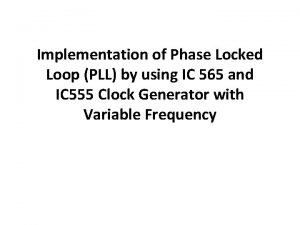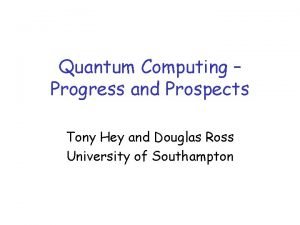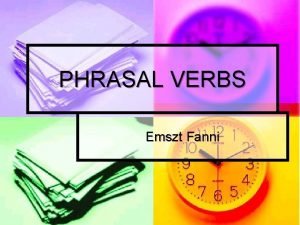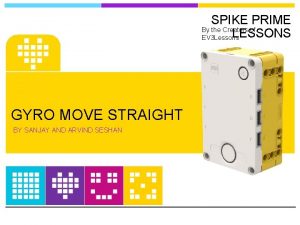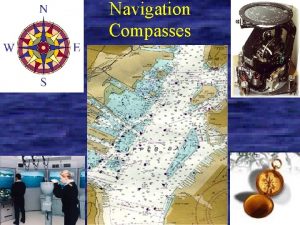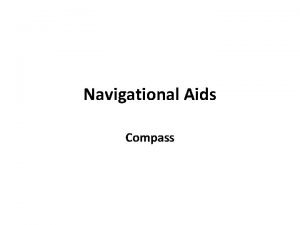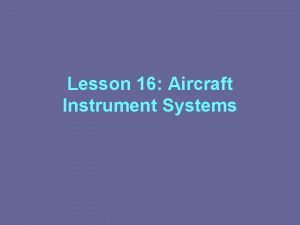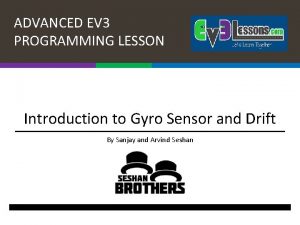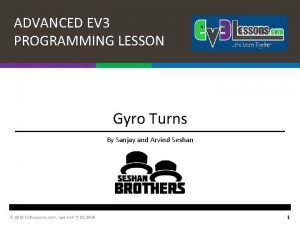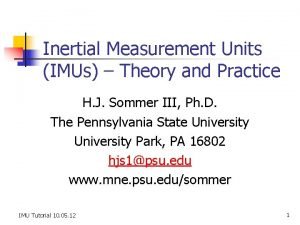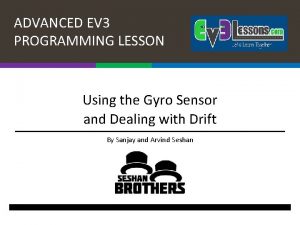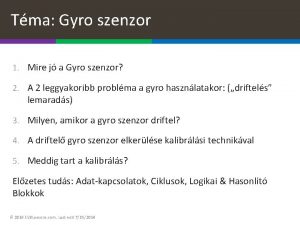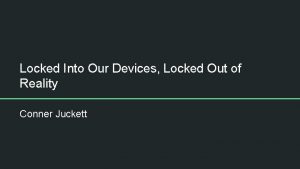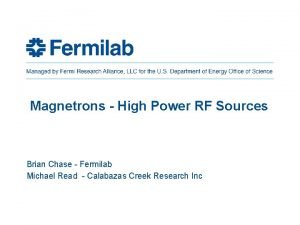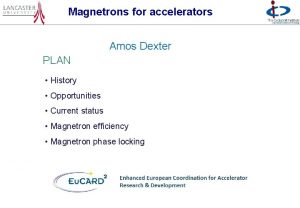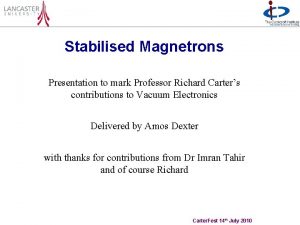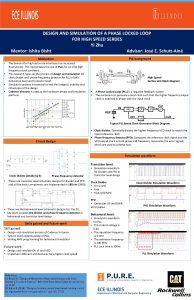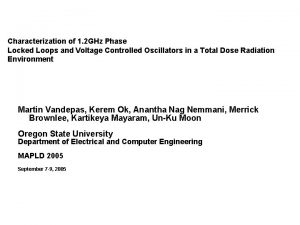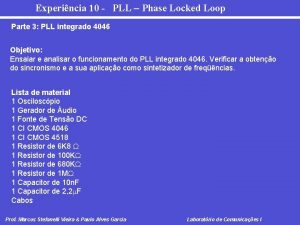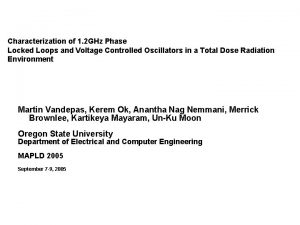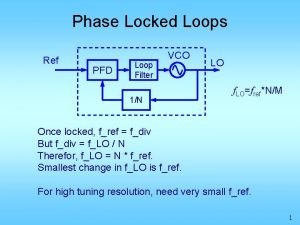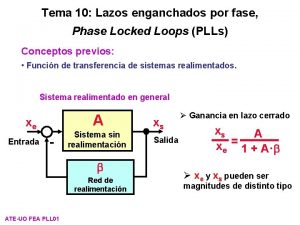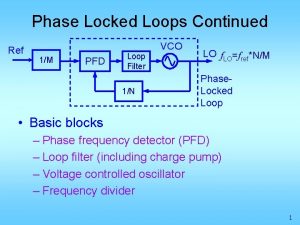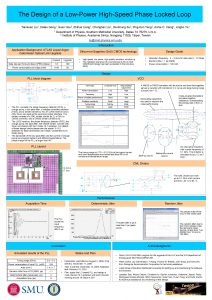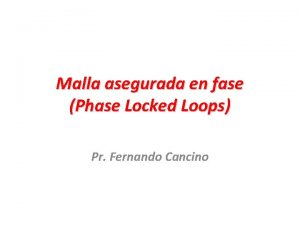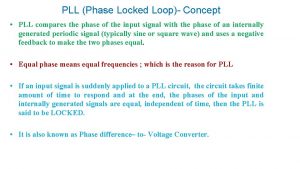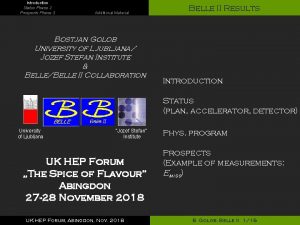Prospects for Phase Locked Magnetrons Magnicons and Gyro




























- Slides: 28

Prospects for Phase Locked Magnetrons, Magnicons and Gyro. Klystrons as RF Power Sources for Accelerators Amos Dexter (speaker), Graeme Burt and Chris Lingwood RF Output B field along axis efficient RF Output Cathode Output Cavity RF Input B field into page Input Cavity inefficient Cathode RF Input Tiara Workshop on RF power generation for accelerators, Uppsala 2013

Bunching Magnetrons, Magnicons and Gyro-Klystrons all have electron orbits that circulate around the magnetic fields lines. Bunching is in the orbit around the magnetic field. The Gyro-Klystron uses a magnetron injection gun (MIG) so the transverse momentum is created close to the gun. Bunching is partly ballastic but also depends on the relativistic cyclotron maser instability. The Magnicon starts with a linear beam and then employs synchronous rotating modes in deflection cavities to spin and bunch the beam. Output for the Gyro-klystron and the Magnicon is a bremsstrahlung process in a “fast wave” output cavity. In a Magnetron electrons have no motion in the direction of the magnetic field. Bunching occurs by the interaction of circulating electrons and the slow wave structure of the anode. As electrons are collected on the capacitive gaps of the slow wave structure hence output can be viewed simply as the synchronous charging of a circuit. As electrons are retarded by the slow wave output it is also a Cherenkov process. Tiara Workshop on RF power generation for accelerators, Uppsala 2013

Groups with recent work on/relevant to cross field devices for accelerators Phase locked magnetrons Varian Associates (MA) (1991) Univ. Mitchigan (-2013) Univ. Lancaster (2003 – 2010) J-Lab (2006 – 2013) Muon Inc. , Fermi-Lab & (2007 – 2013) Treado, Hansen, Jenkins Gilgenbach et al. Dexter, Tahir, Carter, Burt Wang Kazakevich, Yakovlev (Short pulse) (Relativistic Magnetrons) (CW Cooker type) (Power combining) Efficient L Band Magnetrons SLAC, CTL, Raytheon Diado Instit. Tech. Japan (1991) Tantawi et al. (2004) Shibata (1991) (CW Coaxial? 300 k. W) (CW Coaxial 600 k. W Gyro Klystrons IAP Nizhny Novgorad Univ. Maryland Calabazas Creek Magnicons Budker Inst. Nonosibirsk Omega-P Inc, & Yale Lebedev Lawson Kozyrev, Makarov, Nezhevenko, La. Pointe, Shchelkunov, Yakovlev, Hirshfield Gyro TWT (Univ. Strathclyde, MIT , IAP Nizhny Novgorad, Univ. Maryland , NRL Washington, Univ. Mitchigan) Tiara Workshop on RF power generation for accelerators, Uppsala 2013

Magnetrons for Accelerators Single magnetrons 2. 856 GHz, 5 MW, 3 ms pulse, 200 Hz repetition are used to power linacs for medical and security applications. Multiple magnetrons have been considered for high energy normal conducting linacs but the injection power needed for an unstabilised magnetron made it uncompetitive with a Klystron. Overett, T. ; Bowles, E. ; Remsen, D. B. ; Smith, R. E. , III; Thomas, G. E. “ Phase Locked Magnetrons as Accelerator RF Sources” PAC 1987 Benford J. , Sze H. , Woo W. , Smith R. , and Harteneck B. , “Phase locking of relativistic magnetrons” Phys. Rev. Lett. , vol. 62, no. 4, pp. 969, 1989. Treado T. A. , Hansen T. A. , and Jenkins D. J. “Power-combining and injection locking magnetrons for accelerator applications, ” Proc IEEE Particle Accelerator Conf. , San Francisco, CA 1991. Chen, S. C. ; Bekefi, G. ; Temkin, R. J. “ Injection Locking of a Long-Pulse Relativistic Magnetron” PAC 1991 Treado, T. A. ; Brown, P. D. ; Hansen, T. A. ; Aiguier, D. J. “ Phase locking of two longpulse, high-power magnetrons” , IEEE Trans. Plasma Science, vol 22, p 616 -625, 1994 Treado, Todd A. ; Brown, Paul D. , Aiguier, Darrell “New experimental results at long pulse and high repetition rate, from Varian's phase-locked magnetron array program” Proceedings Intense Microwave Pulses, SPIE vol. 1872, July 1993 Courtesy of e 2 v Tiara Workshop on RF power generation for accelerators, Uppsala 2013

Amplifier Selection Magnetron Gyro-Klystron Magnicon Klystron Frequency Above ~ 200 MHz above a few GHz Above ~ 350 MHz Peak Power Lower Very high High Average power Lower High Gain Lower High Tuneable range Large Small Instantaneous bandwidth Very small Small Slew rate Very small Small Noise figure Higher Lower Best Efficiency L band ~ 90% ILC ~ 69% Best Efficiency X band ~ 50% Pushing figure Significant Pulling figure Significant Amplifier cost Low high Modulator & magnet cost Lower very high Very high 50% 60% XL 5 = 40% Significant Tiara Workshop on RF power generation for accelerators, Uppsala 2013

Gyro-Klystron Experimental results Institution IAP, Nizhny Novgorod Univ. Maryland Freq. Output Power (GHz) Mode (MW) 30. 0 TE (5, 3) 15 TE (3, 2) 8. 57 Gain Band- (d. B) width 40% 30 0. 17% 12 30% 38 0. 17% TE (0, 1) 75 32% 30 0. 2% 9. 87 TE (0, 1) 27 32% 36 0. 2% max pow 9. 87 TE (0, 1) 16 37% 33 0. 2% max eff 9. 87 TE (0, 1) 20 28% 35 0. 2% max gain 19. 76 TE (0, 3) 32 29% 27 0. 1% 33 54% 55 46 49% 55 50 40% 50 Calabazas Creek 30. 0 Novosibirsk Magnicon 7. 0 XL 5 Klystron 12. 0 TM(2, 1, 0) Eff. 0. 4% For a review of klystrons verses other source for the NLC see http: //www. slac. stanford. edu/econf/C 10630/papers/T 301. pdf Tiara Workshop on RF power generation for accelerators, Uppsala 2013

Calabazas Creek Gyro-Klystron Tiara Workshop on RF power generation for accelerators, Uppsala 2013

CPI study: Gyroklystron 30 GHz, 50 MW made a design study for CERN in 2001. A 200 MW power station would consist of – four 50 MW Gyroklystrons, 1. 2 μs, 100 Hz with fundamental TE 011 coaxial cavities, – four SC 2 T solenoids + power supplies, (≈ 300 k$ each) – two 15 k. W drivers + power supplies, (≈ 370 k$ each) – one modulator 500 k. V, 1. 2 k. A, (≈ 1000 k$ ) – two power combiners 50 MW + 50 MW (≈ 20 k$ each) – ancillary systems. Lead time ≈3 years (15 months for first 50 MW amplifier) This example would sum up to 7. 5 M$ Slide taken from CLIC test stand study by Erk Jensen Tiara Workshop on RF power generation for accelerators, Uppsala 2013

Opportunities for Magnetrons Lancaster started worked on phase locked magnetrons in 2003 The conceptual application was for intense proton beams as would be required for a neutrino factory or future neutron spallation sources. Magnetrons can become an option for intense proton beams where they give significantly greater efficiency than other devices and bring down the lifetime cost of the machine without sacrificing performance and reliability. The easiest applications are where beam quality is not a key issue. One would consider using multiple magnetrons to drive an accelerator unless cost and efficiency are potentially show stopping considerations. Tiara Workshop on RF power generation for accelerators, Uppsala 2013

Magnetron Size at 704 MHz air cooling for cathode 704 MHz water cooling for anode Magnets dg dm hm dg ~ 360 mm dm ~ 165 mm hm ~ 650 mm cost £ 8000 The magnetron easily fits in the accelerator tunnel and this might offer huge unexpected savings. If an accelerator magnetron design is similar to industrial heating magnetron design, has similar tolerances and can be made on same production line then cost may not be much more air cooling input for dome Tiara Workshop on RF power generation for accelerators, Uppsala 2013

The Reflection Amplifier • Linacs require accurate phase control • Phase control requires an amplifier Cavity • Magnetrons can be operated as reflection amplifiers • They run in saturation which is a problem Compared to Klystrons, in general Magnetrons Magnetron Load Circulator Injection Source - are smaller -can be more efficient at L band - can use permanent magnets (at 704 MHz) - utilise lower d. c. voltage but higher current - are easier to manufacture Consequently they are expected to be much cheaper to purchase and operate J. Kline “The magnetron as a negative-resistance amplifier, ” IRE Transactions on Electron Devices, vol. ED-8, Nov 1961 H. L. Thal and R. G. Lock, “Locking of magnetrons by an injected r. f. signal”, IEEE Trans. MTT, vol. 13, 1965 Tiara Workshop on RF power generation for accelerators, Uppsala 2013

Reflection Amplifier Controllability 1. Phase of output follows the phase of the input signal (amplifier in saturation) 2. 3. Phase shift through magnetron depends on difference between input frequency and the magnetrons natural frequency (same as driving a cavity with a source) Output power has minimal dependence on input signal power 4. Phase shift through magnetron depends on input signal power 5. There is a time constant associated with the output phase following the input phase Anode Voltage 915 MHz 10 k. W 20 k. W 916 MHz 30 k. W 40 k. W 12. 0 k. V 3. 00 A 11. 5 k. V 2. 92 A Magnetron frequency and output vary together as a consequence of 1. Varying the magnetic field 2. Varying the anode current (pushing) 3. Varying the reflected power (pulling) 0 o Arcing Power supply load 11. 0 k. V line 2. 85 A 900 W 10. 5 k. V 2 270 o 2. 70 A 10. 0 k. V 2 3 4 5 800 W 700 W 2. 78 A 1 towards magnetron Moding Magnetic field coil current VSWR 3 4 6 90 o +5 MHz +2. 5 MHz -5 MHz +0 MHz Anode Current Amps -2. 5 MHz 180 o Tiara Workshop on RF power generation for accelerators, Uppsala 2013

Adler’s Equation for Injection Locking J. C. Slater “The Phasing of Magnetrons” MIT Technical Report 35, 1947 Shien Chi Chen “Growth and frequency Pushing effects in Relativistic Magnetron Phase – Locking”, IEEE Trans. on Plasma Science Vol. 18 No 3. June 1990. The basic circuit model for the phased locked magnetron is the same as for a cavity Injection Negative impedance to represent magnetron spokes excitation of -ZS the anode. Includes static pushing effects. L R C Zw Load impedance includes pulling effects. To get Adler’s equation set to give Tiara Workshop on RF power generation for accelerators, Uppsala 2013

Solution of Adler’s Equation Like wo winj y Vinj /RF magnetron ang. oscillation frequency without injection for small y hence phase stabilises to a constant offset injection angular frequency phase shift between injection input and magnetron output equivalent circuit voltage for injection signal / RF output Adler’s equation predicts that : if wo = wi then y → 0 if wo close to wi then y → a fixed value (i. e. when sin y < 1 then locking occurs) if wo far from wi then y → no locking unless Vinj is large Steady state If the natural frequency of the magnetron is fluctuating then the phase y will be fluctuating. High frequency phase jitter will be filtered by a superconducting the cavity Advancing or retarding the injection signal allows low frequency jitter to be cancelled and the magnetron phase or the cavity phase to be maintained with respect to a reference signal. Tiara Workshop on RF power generation for accelerators, Uppsala 2013

Power Needed for Injection Locking The minimum locking power is given when sin y = 1 PRF is output power QL refers to the loaded magnetron. For our 2. 45 GHz cooker magnetron Pushing (fi –fo) due to ripple ~ 2 MHz (fi –fo) due to temperature fluctuation > 5 MHz This is big hence must reduce fi – fo ( can do this dynamically using the pushing curve) Time response ~ ~ 400 ns ~ 1000 RF cycles Tiara Workshop on RF power generation for accelerators, Uppsala 2013

Experiments at Lancaster Double Balance Mixer Oscilloscope 2 Stub Tuner 2 Water Load 1 W Amplifier Loop Coupler C 3 Circulator 1 3 Stub Tuner 1 Circulator 2 Water Load Loop Coupler 10 Vane Magnetron Load IQ Modulator (Amplitude & phase shifter) D/A A/D Power supply ripple Oscilloscope D/A DSP Digital Phase Detector 1. 3 GHz D/A ÷M Magnetron phase no LLRF LP Filter 8 k. Hz cut-off ÷M pk-pk 26 o High Voltage Transformer Frequency Divider / N Divider /R Micro. Controller 10 MHz TCXO 1 ppm 2. 3 - 2. 6 GHz PLL Oscillator ADF 4113 + VCO 40 k. Hz Chopper Magnetron phase with LLRF pk-pk 1. 2 o Pulse Width Modulator SG 2525 1. 5 k. W Power Supply Phase - Freq Detector & Charge Pump ADF 4113 Loop Filter 325 V DC + 5% 100 Hz ripple Tiara Workshop on RF power generation for accelerators, Uppsala 2013

Experiments at Lancaster Tahir I. , Dexter A. C and Carter R. G. “Noise Performance of Frequency and Phase Locked CW Magnetrons operated as current controlled oscillators”, IEEE Trans. Elec. Dev, vol 52, no 9, 2005, pp 2096 -2130 Phase shift keying the magnetron Tahir I. , Dexter A. C and Carter R. G. , “Frequency and Phase Modulation Performance on an Injection-Locked CW Magnetron”, IEEE Trans. Elec. Dev, vol. 53, no 7, 2006, pp 1721 -1729 0 d. Bm RBW = 100 Hz Span = 100 k. Hz Centre = 2. 44998488 GHz Locked spectral output -50 d. Bm Lancaster has successfully demonstrated the injection locking of a cooker magnetron with as little as -40 d. B injection power by fine control the anode current to compensate shifts in the natural frequency of the magnetron. -100 d. Bm -50 k. Hz +50 k. Hz Tiara Workshop on RF power generation for accelerators, Uppsala 2013

Proof of principle Demonstration of CW 2. 45 GHz magnetron driving a specially manufactured superconducting cavity in a VTF at JLab and the control of phase in the presence of microphonics was successful. Tiara Workshop on RF power generation for accelerators, Uppsala 2013

SCRF cavity powered with magnetron Injection but magnetron off Injection + magnetron on + control Injection + magnetron on Tiara Workshop on RF power generation for accelerators, Uppsala 2013

Magnetron study for CERN’s SPL? • Would like to phase each cavity individually • Cavity power requirements increase to ~ 900 k. W • Klystrons more cost effective at the 3 -10 MW scale • IOTs not available to get to 900 k. W • Long pulse L magnetrons should be able to reach 1 MW • Hence use IOTs along the linac up to that point power is insufficient • After that point use IOTs to injection lock magnetrons • Obtain high efficiency where most power is required • Obtain best control at front of linac Tiara Workshop on RF power generation for accelerators, Uppsala 2013

Layout using one magnetron per cavity Permits fast phase control but only slow, full range amplitude control Cavity Standard Modulator Pulse to pulse amplitude can be varied 880 k. W Magnetron Slow tuner ~ -13 d. B to -17 d. B needed for locking i. e. between 18 k. W and 44 k. W hence between 42 k. W and 16 k. W available for fast amplitude control Load 4 Port Circulator 60 k. W IOT Could fill cavity with IOT then pulse magnetron when beam arrives Tiara Workshop on RF power generation for accelerators, Uppsala 2013 LLRF

How do we get high efficiency? Using standard theory one can estimate Magnetic field, anode and cathode radii from requirement data (frequency 704 MHz, efficiency >90% and power Should be able to use same block for efficient generation at both the 500 KW and 1 MW level Tiara Workshop on RF power generation for accelerators, Uppsala 2013

Expected operating range Threshold for moding Short circuit regime VORPAL simulations Tiara Workshop on RF power generation for accelerators, Uppsala 2013

PIC code simulations Voltage in magnetron Volts time (s) Volts The literature suggests that PIC codes give the correct predictions for inefficient magnetrons with solid cathodes. Our simulations have never accurately reproduced performance curves of efficient cook magnetrons with spiral cathodes. time (s) FFT (d. B) time (s) Tiara Workshop on RF power generation for accelerators, Uppsala 2013

Efficient Orbits An efficient orbit should have no loop Orbits associated with the design on the previous slides Tiara Workshop on RF power generation for accelerators, Uppsala 2013

Cost Calculation 20 m. A SPL beam Tiara Workshop on RF power generation for accelerators, Uppsala 2013

Notes for cost calculation Tiara Workshop on RF power generation for accelerators, Uppsala 2013

Prospects • Intense beams in future user facilities need to be generated efficiently. • Developing a new HPRF source is expensive and comparison to available sources is difficult before development is mature. • One would not use a magnetron for a superconducting linac if you could afford a klystron or IOT. • One would not fund the development a new gyro-klystron with the same specification as a klystron which already exists. • Universities will continue to explore new concepts. • Need accelerator labs to explore new devices at accelerator test stands to have any chance of new devices becoming feasible alternatives. • Future accelerators constrained on cost so research on efficient low cost sources is worthwhile. Tiara Workshop on RF power generation for accelerators, Uppsala 2013
 Pll ic 565
Pll ic 565 Quantum computing progress and prospects
Quantum computing progress and prospects In line 2 impatient of is best interpreted as meaning
In line 2 impatient of is best interpreted as meaning Prospects of agriculture in bangladesh
Prospects of agriculture in bangladesh World population prospects
World population prospects Prospects preposition
Prospects preposition Daisuke matsuzaka gyro ball
Daisuke matsuzaka gyro ball Gyro sensor spike prime
Gyro sensor spike prime Compass error
Compass error Gyro tip post removal
Gyro tip post removal Gyro rotor
Gyro rotor First lego league spike prime
First lego league spike prime Aircraft instrument system
Aircraft instrument system What will we do if we use hardware solution for gyro drift
What will we do if we use hardware solution for gyro drift Gyro lessons
Gyro lessons Gyro
Gyro Gyro lesson 1
Gyro lesson 1 Simplified directional facility
Simplified directional facility Gyro survey definition
Gyro survey definition Mobile phase and stationary phase
Mobile phase and stationary phase Stationary and mobile phase
Stationary and mobile phase Detectors used in hplc
Detectors used in hplc Normal phase vs reverse phase chromatography
Normal phase vs reverse phase chromatography M tswett pronunciation
M tswett pronunciation Normal phase vs reverse phase chromatography
Normal phase vs reverse phase chromatography Line vs phase voltage
Line vs phase voltage Phase to phase voltage
Phase to phase voltage Broad phase vs narrow phase
Broad phase vs narrow phase You must put all chemicals and drugs in locked cupboards
You must put all chemicals and drugs in locked cupboards
